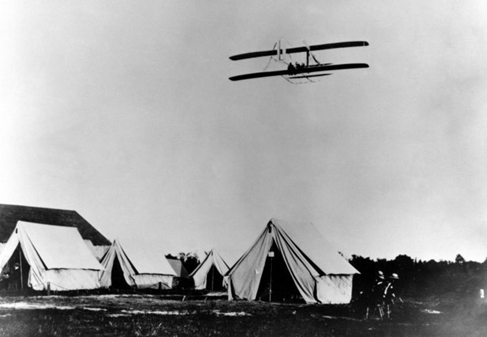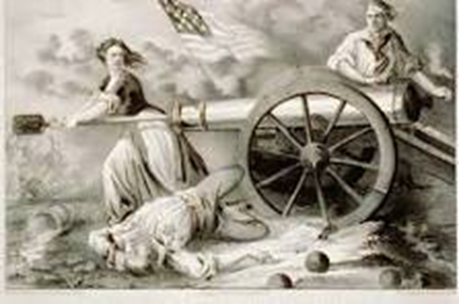On December 17, 1903, Wilbur and Orville Wright made the first controlled, sustained flight of a powered, heavier-than-air aircraft four miles south of Kitty Hawk, North Carolina, introducing the era of air travel.
 In 1904, the motorcycle racer Glenn Curtiss, grandson of a Methodist-Episcopal clergyman, supplied a motorcycle engine to propel the California Arrow, enabling it to become the first successful powered dirigible.
In 1904, the motorcycle racer Glenn Curtiss, grandson of a Methodist-Episcopal clergyman, supplied a motorcycle engine to propel the California Arrow, enabling it to become the first successful powered dirigible.
 In 1907, Curtiss set the world record of 136.36 miles per hour with a V-8 engine he designed, becoming “the fastest man in the world.”
In 1907, Curtiss set the world record of 136.36 miles per hour with a V-8 engine he designed, becoming “the fastest man in the world.”
 Alexander Graham Bell encouraged Curtiss to join his Aerial Experiment Association, and in 1908 Curtiss built his famous June Bug. He received U.S. Pilot’s License #1 from the Aero Club of America.
Alexander Graham Bell encouraged Curtiss to join his Aerial Experiment Association, and in 1908 Curtiss built his famous June Bug. He received U.S. Pilot’s License #1 from the Aero Club of America.

 In 1910, Glenn Curtiss made the first long-distance flight, from Albany to New York City, winning a prize of $10,000 from publisher Joseph Pulitzer. The same year, he simulated the first aircraft bombing runs, was the first to use firearms in flight, made first radio communication with aircraft, and was the first to take off from a Navy ship, earning him the title “Father of Naval Aviation.”
In 1910, Glenn Curtiss made the first long-distance flight, from Albany to New York City, winning a prize of $10,000 from publisher Joseph Pulitzer. The same year, he simulated the first aircraft bombing runs, was the first to use firearms in flight, made first radio communication with aircraft, and was the first to take off from a Navy ship, earning him the title “Father of Naval Aviation.”
On October 11, 1910, in an impromptu meeting, 26-year-old aviator Arch Hoxsey, a mechanic for the Wright brothers, invited former President Theodore Roosevelt to join him for a flight in a Wright Model AB at Kinloch Field outside St. Louis, Missouri: “Colonel, I’d like to have you go up with me,” asked Hoxsey, who mentioned that he and Roosevelt shared the same birthday, October 27. “After I told him that he smiled. As soon as I saw his smile, I knew I had him.” Taking off, they flew a few passes over the field and landed. Roosevelt “smiling his most expansive smile,” vigorously shook Hoxsey’s hand, saying “It was great! It was the finest experience I ever had.”
 A little over two months later, December 26, 1910, Hoxsey set the altitude record of flying 11,474 feet, reporting that the sub-zero temperature and wind chill at that height was “the most terrifying cold I ever felt.” Sadly, five days later, trying to break his record, he lost control and crashed to his death.
A little over two months later, December 26, 1910, Hoxsey set the altitude record of flying 11,474 feet, reporting that the sub-zero temperature and wind chill at that height was “the most terrifying cold I ever felt.” Sadly, five days later, trying to break his record, he lost control and crashed to his death.
 In 1911, Glenn Curtiss developed the first retractable landing gear and the first pontoon aircraft, the first aircraft purchased by the U.S. Navy, and carried out the first catapult launch from a ship.
In 1911, Glenn Curtiss developed the first retractable landing gear and the first pontoon aircraft, the first aircraft purchased by the U.S. Navy, and carried out the first catapult launch from a ship.
 He created the first flying school, in Miami, and trained the first American female pilot, Blanche Stuart Scott.
He created the first flying school, in Miami, and trained the first American female pilot, Blanche Stuart Scott.
 Curtiss established the first military flying school in San Diego at the Naval Air Station North Island — “The Birthplace of Naval Aviation.”
Curtiss established the first military flying school in San Diego at the Naval Air Station North Island — “The Birthplace of Naval Aviation.”
 Curtiss and the Wright Brothers had a decade long legal battle over the patent of “ailerons” used to control rolling and banking. This delayed further development, allowing Europe and Japan to make advances in aviation. The two companies eventually merged in 1929 to form the Curtiss-Wright Corporation.
Curtiss and the Wright Brothers had a decade long legal battle over the patent of “ailerons” used to control rolling and banking. This delayed further development, allowing Europe and Japan to make advances in aviation. The two companies eventually merged in 1929 to form the Curtiss-Wright Corporation.
 In 1916, the Curtiss Model J was the first aircraft used in a U.S. military operation, carrying out surveillance of Pancho Villa’s forces in Mexico.
In 1916, the Curtiss Model J was the first aircraft used in a U.S. military operation, carrying out surveillance of Pancho Villa’s forces in Mexico.
 During World War I, the airplane was used in reconnaissance replacing the Zepplin.
During World War I, the airplane was used in reconnaissance replacing the Zepplin.
 Also in WWI, it was used in combat, with famed pilots being Germany’s Red Baron and America’s Eddie Rickenbacker who shot down 27 German planes.
Also in WWI, it was used in combat, with famed pilots being Germany’s Red Baron and America’s Eddie Rickenbacker who shot down 27 German planes.
 After the War, the Army sold thousands of surplus “Jenny’s” at bargain prices, resulting in it becoming the “backbone of American postwar civil aviation.”
After the War, the Army sold thousands of surplus “Jenny’s” at bargain prices, resulting in it becoming the “backbone of American postwar civil aviation.”
 The Post Office Department formally established domestic U.S. Air Mail on May 15, 1918.
The Post Office Department formally established domestic U.S. Air Mail on May 15, 1918.
 During the Roaring Twenties, “barnstorming” became the first major form of civil aviation in history. Barnstormers would “buz” villages and drop flyers inviting people to see dare-devil aerobatic stunts.
During the Roaring Twenties, “barnstorming” became the first major form of civil aviation in history. Barnstormers would “buz” villages and drop flyers inviting people to see dare-devil aerobatic stunts.
 Barnstormers performed nose dives, loop-the-loops, spins, barrel rolls, wing walking, parachuting, trapeze, target shooting, dancing on plane’s wings, hitting golf balls, playing tennis, and flying through barns.
Barnstormers performed nose dives, loop-the-loops, spins, barrel rolls, wing walking, parachuting, trapeze, target shooting, dancing on plane’s wings, hitting golf balls, playing tennis, and flying through barns.
 Notable barnstormers were “The Five Blackbirds” (an African American flying group); Wiley Post, who later discovered the jet stream and designed the first pressure suit; and Upside-Down Clyde Pangborn, who later flew the first non-stop flight across the Pacific Ocean. Barnstormers, such as Charles Lindbergh, offered short plane rides for a fee of five dollars.
Notable barnstormers were “The Five Blackbirds” (an African American flying group); Wiley Post, who later discovered the jet stream and designed the first pressure suit; and Upside-Down Clyde Pangborn, who later flew the first non-stop flight across the Pacific Ocean. Barnstormers, such as Charles Lindbergh, offered short plane rides for a fee of five dollars.
One person who took a short ride with a barnstormer was Amelia Earhart at Long Beach, on December 28, 1920. She said: “By the time I had got two or three hundred feet off the ground, I knew I had to fly.”
 Eventually, after some high profile accidents, the government passed regulations designating the minimum altitude at which stunts could be performed. This resulted in them being so high up that spectators could not view them, leading to the popularity of barnstorming declining. So, once again our federal government messed things up with government over-regulation.
Eventually, after some high profile accidents, the government passed regulations designating the minimum altitude at which stunts could be performed. This resulted in them being so high up that spectators could not view them, leading to the popularity of barnstorming declining. So, once again our federal government messed things up with government over-regulation.
One of the greatest feats in aviation was on May 20, 1927, at 7:52am. 25-year-old Charles A. Lindbergh left Roosevelt Field in Long Island, New York, in his silver monoplane named The Spirit of St. Louis.
 Thirty-three and a half hours later he landed in Paris, completing the first solo flight across the Atlantic Ocean.
Thirty-three and a half hours later he landed in Paris, completing the first solo flight across the Atlantic Ocean.
 Lindbergh was decorated by the President of France, the King of England and President Calvin Coolidge.
Lindbergh was decorated by the President of France, the King of England and President Calvin Coolidge.
 The son of a Congressman, Charles Lindbergh was a test pilot for a St. Louis firm, performed feats of barnstorming and became an Air Service Reserve cadet, flying mail routes to Chicago. At the Institute of Aeronautical Sciences, February 1, 1954, Charles Lindbergh stated: “It was not the outer grandeur of the Roman but the inner simplicity of the Christian that lived through the ages.”
The son of a Congressman, Charles Lindbergh was a test pilot for a St. Louis firm, performed feats of barnstorming and became an Air Service Reserve cadet, flying mail routes to Chicago. At the Institute of Aeronautical Sciences, February 1, 1954, Charles Lindbergh stated: “It was not the outer grandeur of the Roman but the inner simplicity of the Christian that lived through the ages.”
 On the Bicentennial of Air and Space Flight, February 7, 1983, President Ronald Reagan said: “We Americans have always been at our best when we’ve faced challenge. Whether Daniel Boone or Charles Lindbergh; I’ve always believed that mankind is capable of greatness. But it depends on us. God gave angels wings. He gave mankind dreams. And with His help, there’s no limit to what can be accomplished.”
On the Bicentennial of Air and Space Flight, February 7, 1983, President Ronald Reagan said: “We Americans have always been at our best when we’ve faced challenge. Whether Daniel Boone or Charles Lindbergh; I’ve always believed that mankind is capable of greatness. But it depends on us. God gave angels wings. He gave mankind dreams. And with His help, there’s no limit to what can be accomplished.”
In 1957, CinemaScope produced the movie The Spirit of St. Louis, starring Jimmy Stewart as Charles Lindbergh.
 President Gerald Ford remarked at the Fort McHenry National Monument in Baltimore, July 4, 1975: “We need to remind ourselves that America is really ‘the land of the free and the home of the brave.’ And we should be proud of it. The Wright brothers mastered powered flight at Kitty Hawk. The age of flight was born. From the first Atlantic crossing by the ‘Lone Eagle,’ of Charles Lindbergh;
President Gerald Ford remarked at the Fort McHenry National Monument in Baltimore, July 4, 1975: “We need to remind ourselves that America is really ‘the land of the free and the home of the brave.’ And we should be proud of it. The Wright brothers mastered powered flight at Kitty Hawk. The age of flight was born. From the first Atlantic crossing by the ‘Lone Eagle,’ of Charles Lindbergh;
 to the American astronauts who announced that the Eagle had landed, when it touchdown on the Moon, America’s leadership was again established. The modern world places a premium on creativity and individuality. Individualism is a safeguard against the sameness of society.
to the American astronauts who announced that the Eagle had landed, when it touchdown on the Moon, America’s leadership was again established. The modern world places a premium on creativity and individuality. Individualism is a safeguard against the sameness of society.
 He continued: “A government too large and bureaucratic can stifle individual initiative by a frustrating statism. In America our sovereign is the citizen, and we must never forget it. Governments exist to serve people. The state is the creature of the populace”
He continued: “A government too large and bureaucratic can stifle individual initiative by a frustrating statism. In America our sovereign is the citizen, and we must never forget it. Governments exist to serve people. The state is the creature of the populace”
Ford concluded: “There is a quotation that I learned in my early days in Sunday school, that the beauty of Joseph’s coat is its many colors. And that is the strength of America. We are not Americans alone by birth or blood, by oath or creed. We are Americans because we deliberately chose to be one nation, indivisible, and for 199 years, with God’s help, we have gone forward together, and we will in the future.
We have a free government that checks and balances its own excesses and a free economic system that corrects its own errors. This is the amazing history Americans have written. And it still remains, in Lincoln’s words, ‘The last, best hope of earth.'”




